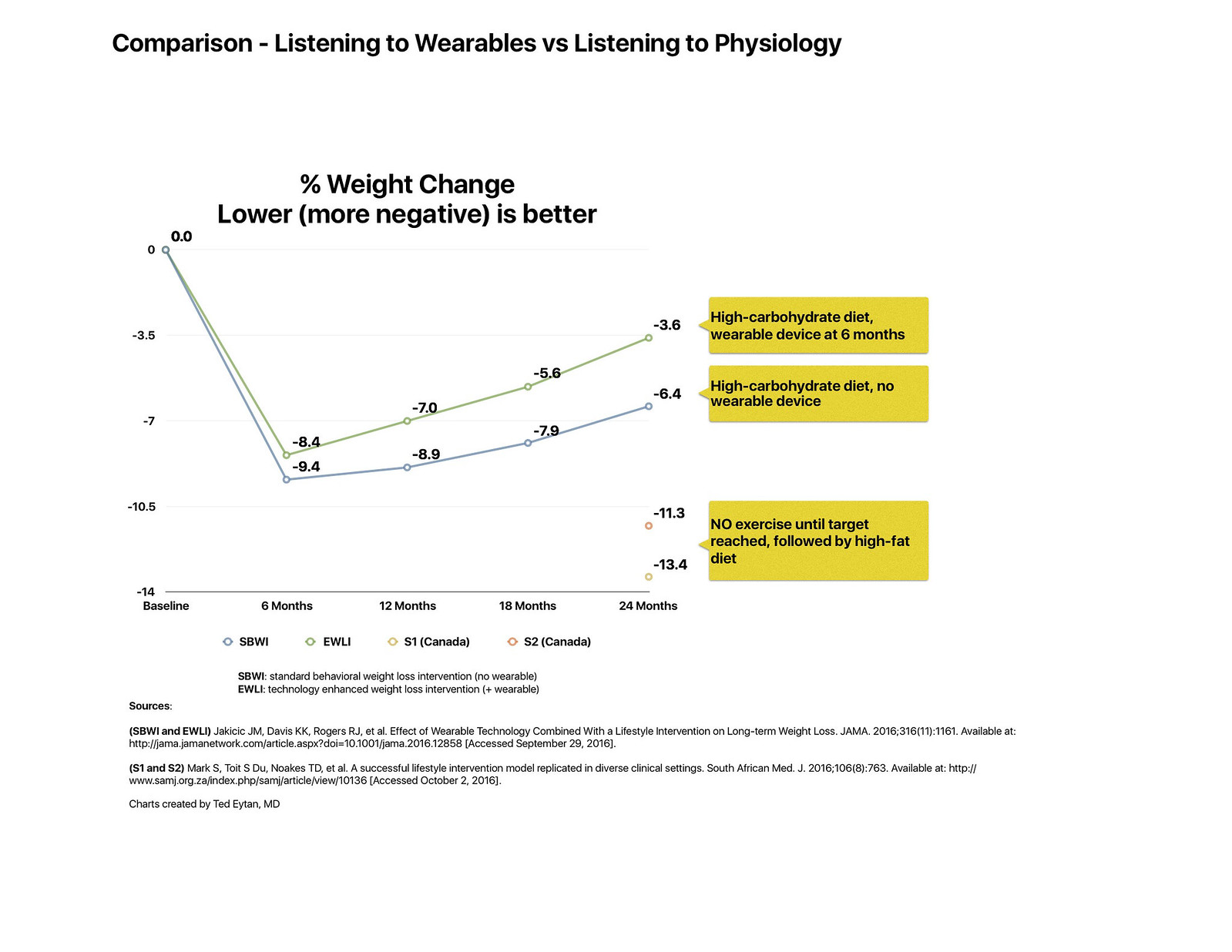
After reading the study about the impact of (a certain type of) wearable devices on weight loss (See: Just Read: Study – Wearables don’t improve weight loss – can you outrun a bad diet? ) – answer, not much – I also read this study at the same time that focused on exercise and diet in a very different way, and had much different outcomes.
In Mark S, Toit S Du, Noakes TD, et al. A successful lifestyle intervention model replicated in diverse clinical settings. South African Med. J. 2016;106(8):763. Available at: http://www.samj.org.za/index.php/samj/article/view/10136 [Accessed October 2, 2016], a few conventional and unconventional things were tried in a group of willing subjects interested in weight loss:
- Behavioral intervention – variable timeframe (conventional)
- Caloric restriction until the reaching of weight goal, including fat, sugar, refined cardohydrate restriction (conventional)
- NO moderate or vigorous exercise until weight goal achieved (UNconventional)
- HIGH fat diet after weight goal achieved (UNconventional>
Foods consumed on the maintenance diet included beef, poultry, fish, eggs, oils, moderate amounts of hard cheeses, and small amounts of nuts, nut butters, seeds and berries.
I can’t determine the actual time to follow-up for the groups, but it looks to be around 2 years, which is the same time as the group in the wearables study. Therefore, I charted the two groups (S1 and S2, for “site 1” and “site 2” in rural practices in British Columbia, Canada) along side the results of the subjects in the wearable study, above (click to enlarge).
Lots of caveats
- The interventions were different, however both interventions involved manipulation of diet. For the wearables subjects, it was caloric restriction and low-fat (high carbohydrate). For the Canadian subjects it was caloric restriction initially, and then transition to high fat (low carbohydrate).
- The populations are different, and the starting weights of the subjects makes it hard to compare % weight loss, although to my eyes, they started out pretty close in weight
- Neither study controlled for diet, meaning there was no comparison group of people who didn’t have their diet manipulated
This is also the part where conflict of interest disclosures are important.
For the wearables article:
Conflict of Interest Disclosures: Dr Jakicic reported receiving an honorarium for serving on the Scientific Advisory Board for Weight Watchers International; serving as principal investigator on a grant to examine the validity of activity monitors awarded to the University of Pittsburgh by Jawbone Inc; and serving as a co-investigator on grants awarded to the University of Pittsburgh by HumanScale, Weight Watchers International, and Ethicon/Covidien. Dr Rogers reported serving as principal investigator on a grant awarded to the University of Pittsburgh by Weight Watchers International. Dr Marcus reported receiving an honorarium for serving on the Scientific Advisory Board for Weight Watchers International. No other disclosures were reported.
For the lifestyle intervention article:
Conflicts of interest. SDT, KN, DC, MM, SVDS and JF have no conflicts of interest to declare. SM is the founder of a sole proprietorship, Approach Analytics, providing analytical support to clinical and public health initiatives. JW is on the Scientic Advisory Board for Atkins Nutritionals Inc. and has accepted honoraria and travel expenses to attend meetings. TN is the author of the books Lore of Running and Waterlogged and co-author of e Real Meal Revolution, Raising Superheroes and Challenging Beliefs. All royalties from the sales of e Real Meal Revolution and Raising Superheroes and related activities are donated to the Noakes Foundation, of which he is the chairman and which funds research on insulin resistance, diabetes and nutrition as directed by its Board of Directors. Money from the sale of other books is donated to the Tim and Marilyn Noakes Sports Science Research Trust, which funds the salary of a senior researcher at the University of Cape Town, South Africa. The research focuses on the study of skeletal muscle in African mammals with some overlap to the study of type 2 diabetes in carnivorous mammals and of the e ects of (scavenged) sugar consumption on free- living (wild) baboons.
The unconventionality of the the intervention is mentioned in the article as something that was hard for others to accept:
Despite the rigour of our quality improvement process, our efforts to communicate the merits of this intervention to health system administrators met with a frustrating lack of uptake. This is not surprising, given that the research literature has many competing ‘solutions’ for the epidemics of obesity and diabetes,[15] many of which are difficult to falsify.[16]
From my understanding of the culture of medicine, something like this written in a scholarly article is usually a vast understatement.
The next several months/years are going to be exciting in this part of health, now that we have a better understanding of physiology and newer tools to (potentially) change our environment and our behavior (maybe).
1 Comment
I recently read The Big Fat Surprise by Nina Teicholz and was indeed surprised (pleasantly I might add) at the findings. Saturated fat is not bad for us.